Club football is back, and with it, the excitement shared by fans of all clubs that this year could be their year. While many may argue that leagues such as the Premier League are predictable in terms of who wins the title as lately it is usually either Manchester City or Liverpool, EFL League One is far from predictable and is extremely difficult to earn promotion from.
One thing that gives any side a huge helping hand, though, is the presence of a striker who can contribute with goals throughout the season as well as help out in build-up play. Wigan Athletic’s Will Keane and Sunderland’s Ross Stewart shared the golden boot accolade in League One last season, both grabbing 26 league goals each.
Historically, there are usually a select number of names you would predict to hit decent numbers within the scoring charts but there are also some fresh names that enter the fold as the season progresses. This data analysis aims to see which strikers in League One could be the difference for their respective clubs this season as it compares the 2021/22 statistics of 24 strikers – one from each club, with an analysis of several key areas for an attacker.
Criteria
This data analysis looks to identify the strikers in League One that could be dangerous this season, so while some clubs may have seen a midfielder win their golden boot award, they will not be included in this report. We have included players who are listed primarily as a striker over at the Transfermarkt website – this also means that some players who are listed as wingers/midfielders on there will miss out, even if they have featured as a striker on occasion. The data used will be from the 2021/22 season – all competitions included.
The strikers selected for this data analysis all fall under the same bracket – they were all the top scorers in the previous campaign for the club they are playing at this season. This, of course, means that some players involved may have been at a different club last season but still scored more goals than any striker at their new club. For example, James Norwood will be playing for Barnsley this season. He scored seven goals last season for Ipswich Town in all competitions, and while he wasn’t their top scorer in 2021/22, he scored more goals in that campaign that any striker currently in the Barnsley squad.
There are, however, two exceptions to that rule. Due to unavailable data and statistics, the qualifying strikers at Accrington Stanley and Fleetwood Town are not included in the graphs, but they will be discussed in certain parts of the report.
Pure attacking contributions
It makes sense to look at the statistical data that relates to the business end of being a striker – scoring goals, shooting, and assisting goals. It goes without saying, any striker worth their salt obviously chips in with a good number of goals, but they should also show range in their attacking play, regardless of their style. The analysis segments below will provide statistics from all 22 players in the relevant key areas.
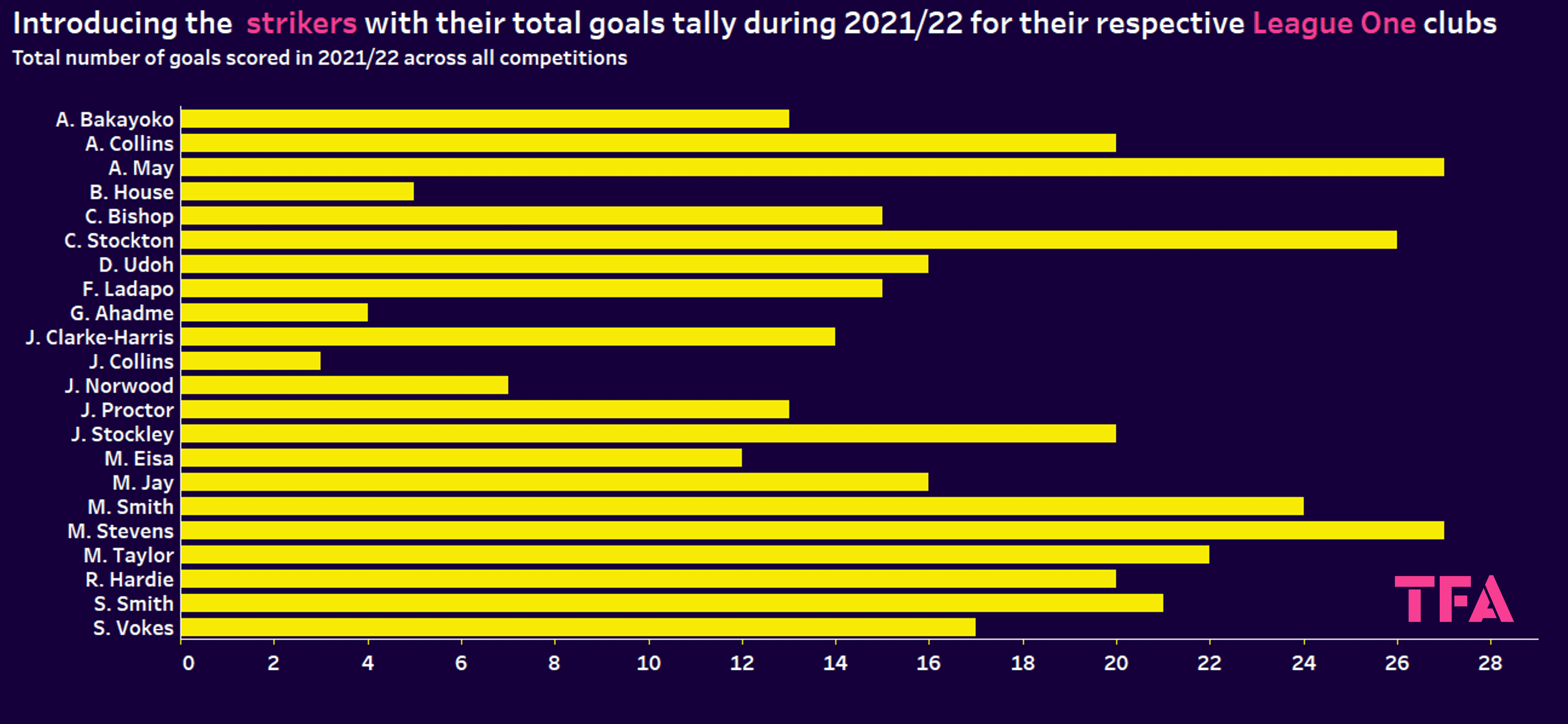
This first graph serves two purposes – it introduces each player that is to be involved in this data analysis report while giving you an overall impression of their goalscoring ability, as they are the top scorers from last season at their current clubs. As mentioned in the introduction, data from cup competitions is also included as they still provide a test for strikers. Straight away, you’ll realise a number of players who struggled and registered low numbers, and a batch of strikers who look clinical.
Players like Alfie May (Cheltenham), Mathew Stevens (Forest Green Rovers) both severely impress with a total of 27 goals each – Cole Stockton would’ve been happy with his total of 26 goals too. Michael Smith (24), Matty Taylor (22), Sam Smith (21), Aaron Collins, Jayden Stockley, and Ryan Hardie (all 20) also had extremely positive seasons too while being a constant threat at goal. There is a small group that will look to build on a good goals record too – players like Sam Vokes, Daniel Udoh, Colby Bishop, and Freddie Ladapo to name a few could be instrumental to their respective teams’ seasons.
On the other end of the scale, a number of clubs will be hoping for more from their front men this time around. James Norwood will look to bring more to the table than seven goals for Barnsley as they look to bounce back to the Championship. The experienced James Collins only managed three goals in the Championship for Cardiff City and will look to be of more use to Derby County in their rebuild. Lincoln City striker Ben House will look to improve on his record of five goals from last season as well, although it is worth mentioning that a fraction of his goals came at National League level for Eastleigh before he made the move to Lincoln mid-way through the season.
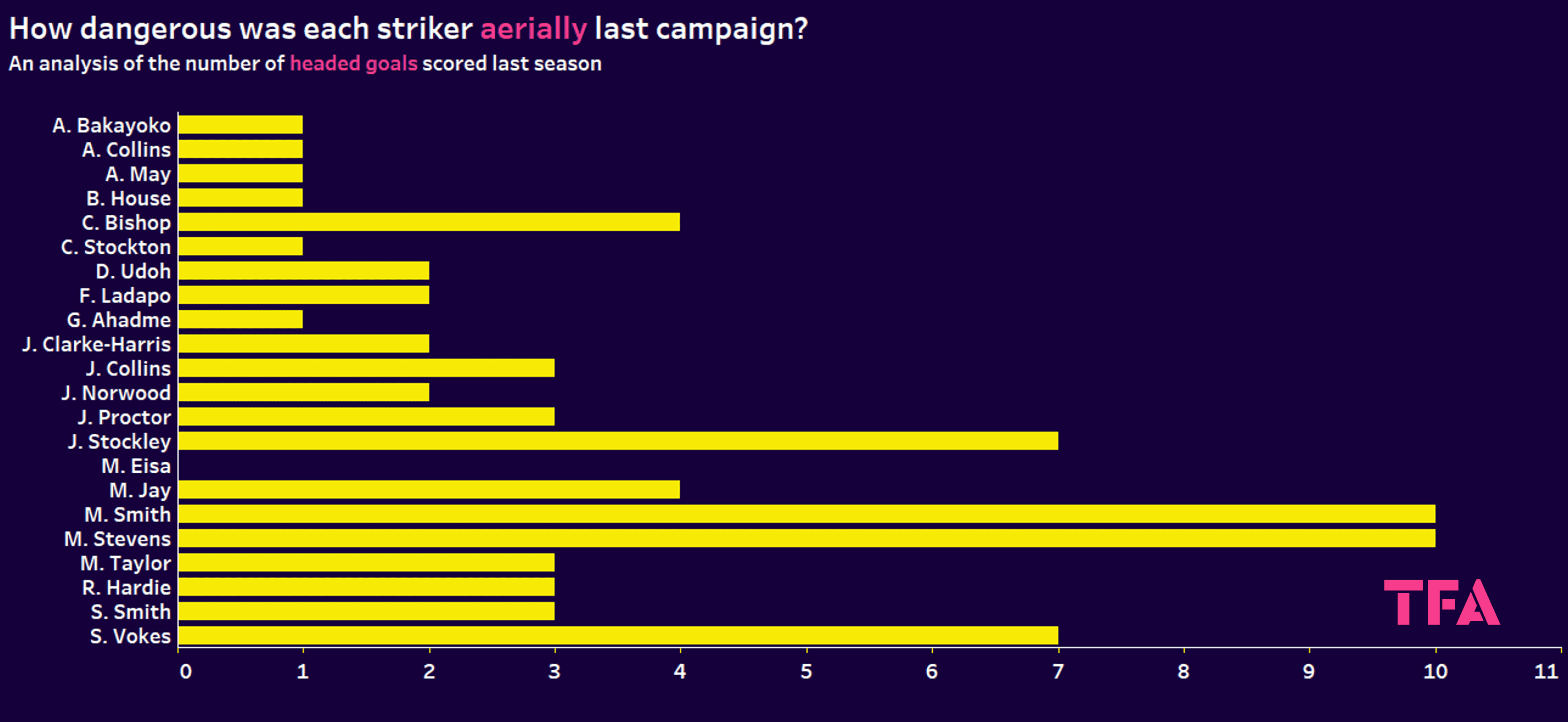
Regardless of which tactics are deployed by a club, physicality is key for a striker as they will face a high amount of aggressive and physically imposing defenders, so being able to challenge in the air inside the box is an important skill – one which also shows a good range in playing style. The graph above displays the number of headed goals scored by each player last season.
Straight away, Michael Smith of Sheffield Wednesday and Forest Green’s Mathew Stevens both impress with 10 headed goals to their name, quite a phenomenal feat. Jayden Stockley and Sam Vokes also showed good aerial ability, both recording seven headed goals.
Moe Eisa will look to improve on his failure to register a single headed goal last term. In contrast, players such as Cole Stockton, Ben House, Alfie May, Gassan Ahadme, Aaron Collins, and Amadou Bakayoko (all on one) will look to provide more a varied threat in 2022/23 to further their attacking game. Of course, player heights and the tactics of their respective clubs may simply limit the opportunity for headed goals.
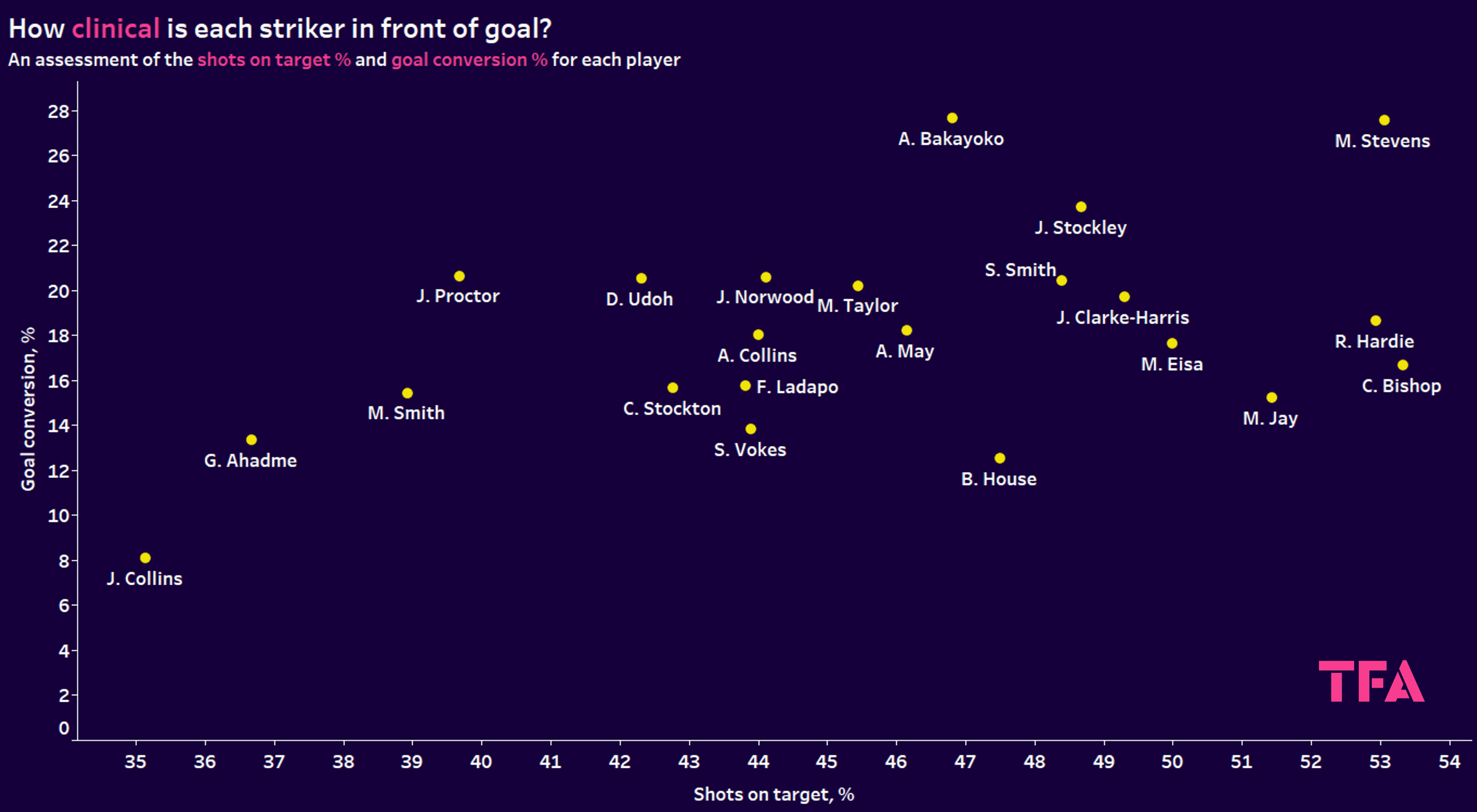
This scatter graph allows us to dig a little deeper into the efficiency of each striker as it compares their percentage registers for shots on target and goal conversions. These statistics can give us a good picture of who is a consistent threat in front of goal and who may be more prone to wasting chances.
There is a cluster of strikers towards the far-right corner of this graph, indicating that they have good general shot accuracy and reliability. Mathew Stevens’ name comes up in a positive light once again thanks to his record of 53.06% shot accuracy next to his goal conversion rate of 27.55% – the second highest conversion rate in this data set. Ryan Hardie does have an average conversion rate (18.627), but he also has the third-highest shots on target rate at 52.94%. On the flip of Hardie’s register, Bakayoko’s statistics indicate an average shot on target rate, but an exceptional conversion rate of 27.66% – the highest goal conversion rate in the set.
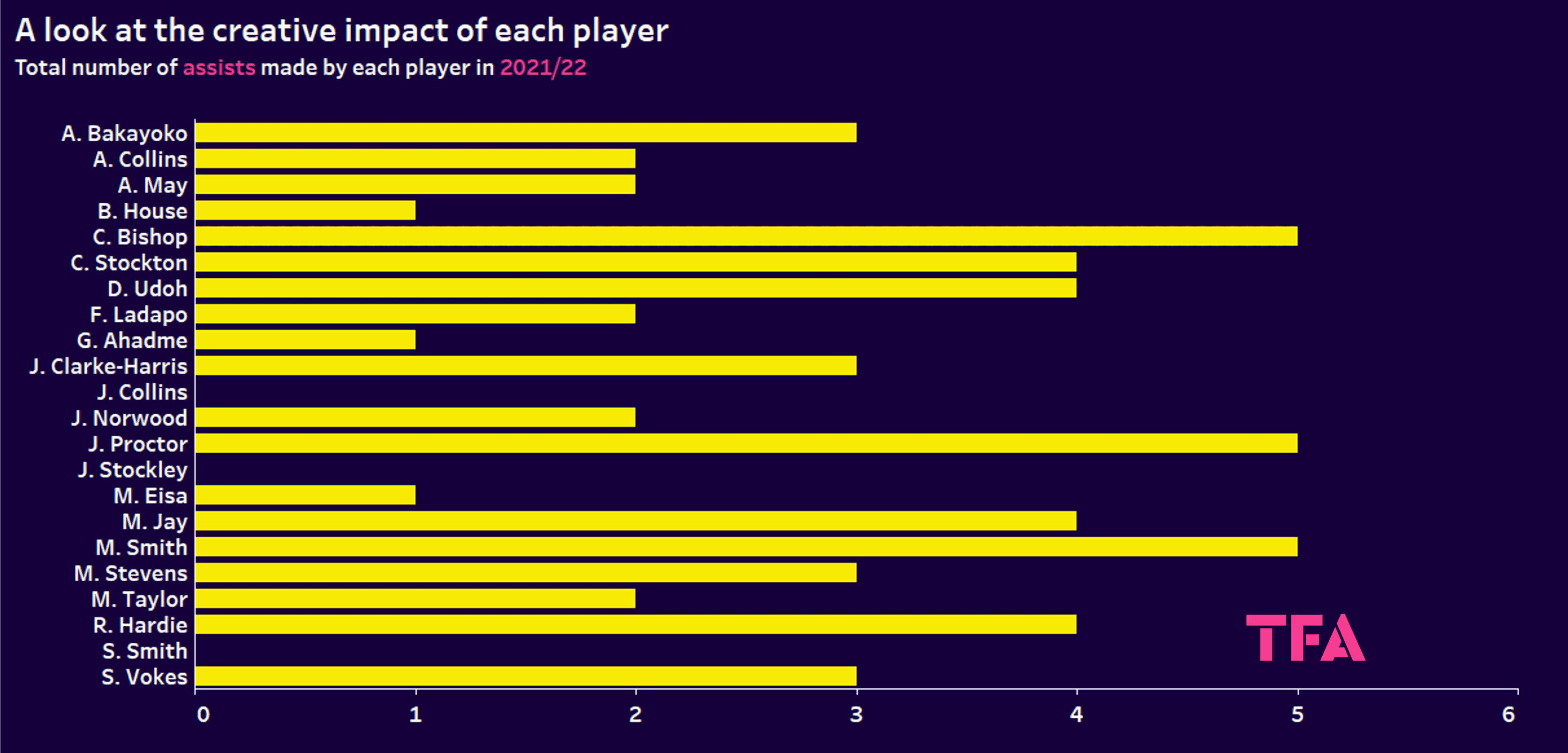
While the primary job of a striker is to score goals, it is also important for them to possess the ability to create goals from time to time as well. As with the previous graph, it shows a variety in play style, as players sometimes have to adapt to provide goals to teammates. The graph above measures each player’s performance regarding the recording of assists.
Jamie Proctor (Port Vale), Colby Bishop (Portsmouth), and Michael Smith (Sheffield Wednesday) all lead the way with an admirable five assists to their name, showing that they have creative elements in their game aside from goalscoring. Matt Jay (Exeter City), Cole Stockton (Morecambe), Ryan Hardie (Plymouth), and Daniel Udoh (Shrewsbury) all show similar qualities with four assists each. Again, the tactics of each club will impact just how much a striker can be involved in the build-up phase, and this may reflect the performance of some players in this area.
Presence in other areas of the game
Following on from the ability to directly assist goals, it makes sense to discuss the importance of a striker’s presence in other areas other than goal-scoring/creating chances. Areas such as general passing, dribbling, and ability to hold onto the ball are all valuable assets for any League One striker, and their contributions defensively can also be key.
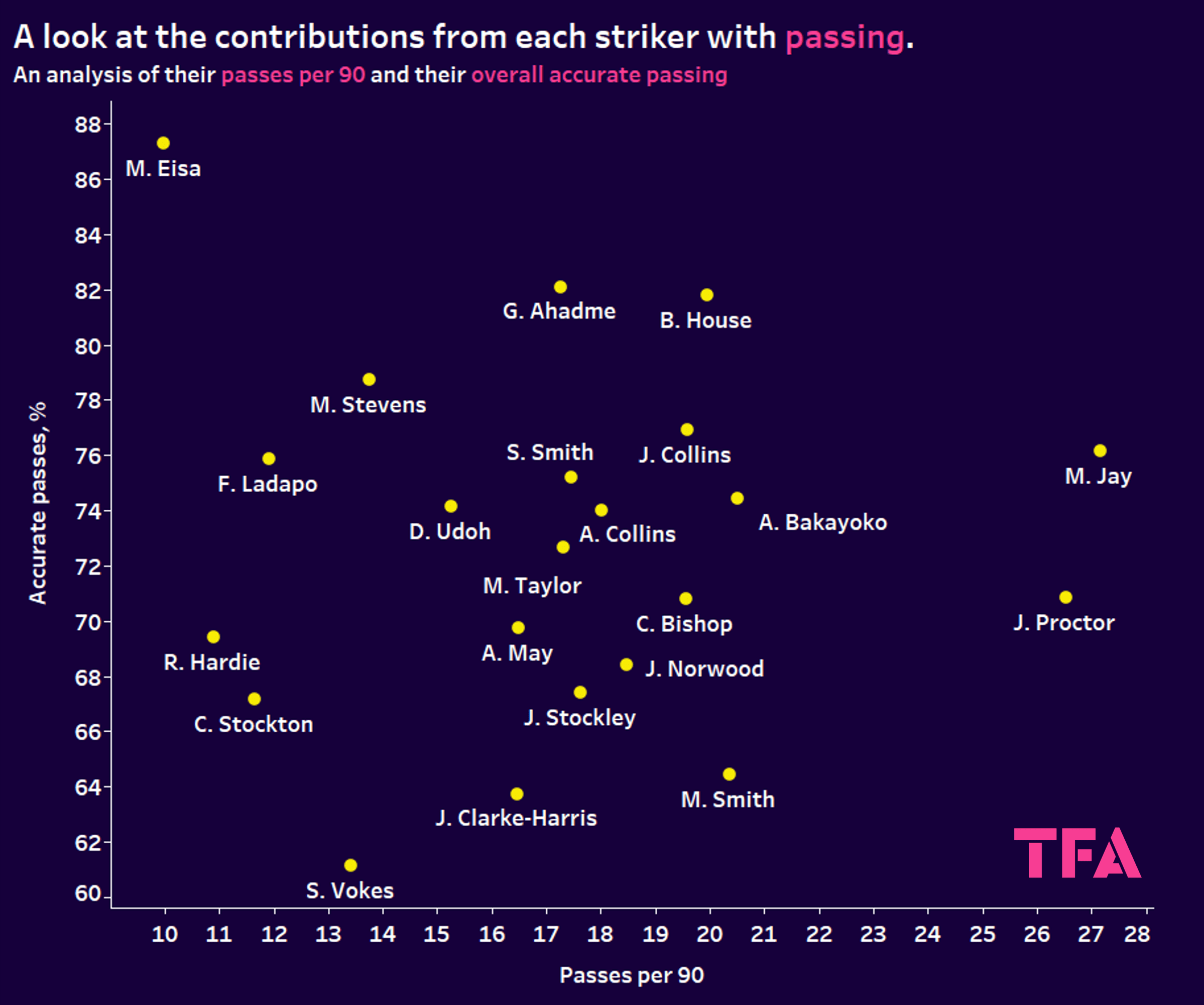
Here we see a representation of how capable each player is in the passing department. Now, the reason we have only included overall passing in this analysis and discounted areas like forward passing, passes into the final third, long passes, etc, is due to the natural role and positioning of the striker.
For instance, even if they make a backwards or lateral pass, chances are they are already high up the pitch so it wouldn’t slow the attack down all that much, hence the lack of a need to provide an analysis into that. With that being said, their ability to pass in general is essential as it could make or break an attacking move. The graph above tells us the average of passes each player records per 90 minutes, along with their overall pass accuracy ratings.
Mo Eisa didn’t average a high number of passes per match (9.99 – the lowest of the data set), suggesting that his club’s tactics last season may have left him isolated at times, but his pass accuracy is more than impressive for a striker. With an accuracy rating of 87.29%, he has shown us true consistency in passing when called upon. This will please MK Dons as it looks like Eisa is a reliable figure to involve in build-up play phases. Matt Jay averages the most passes per 90 (8.97) and he backs it up with a decent accuracy of 76.14%, showing a strong versatility in his arsenal.
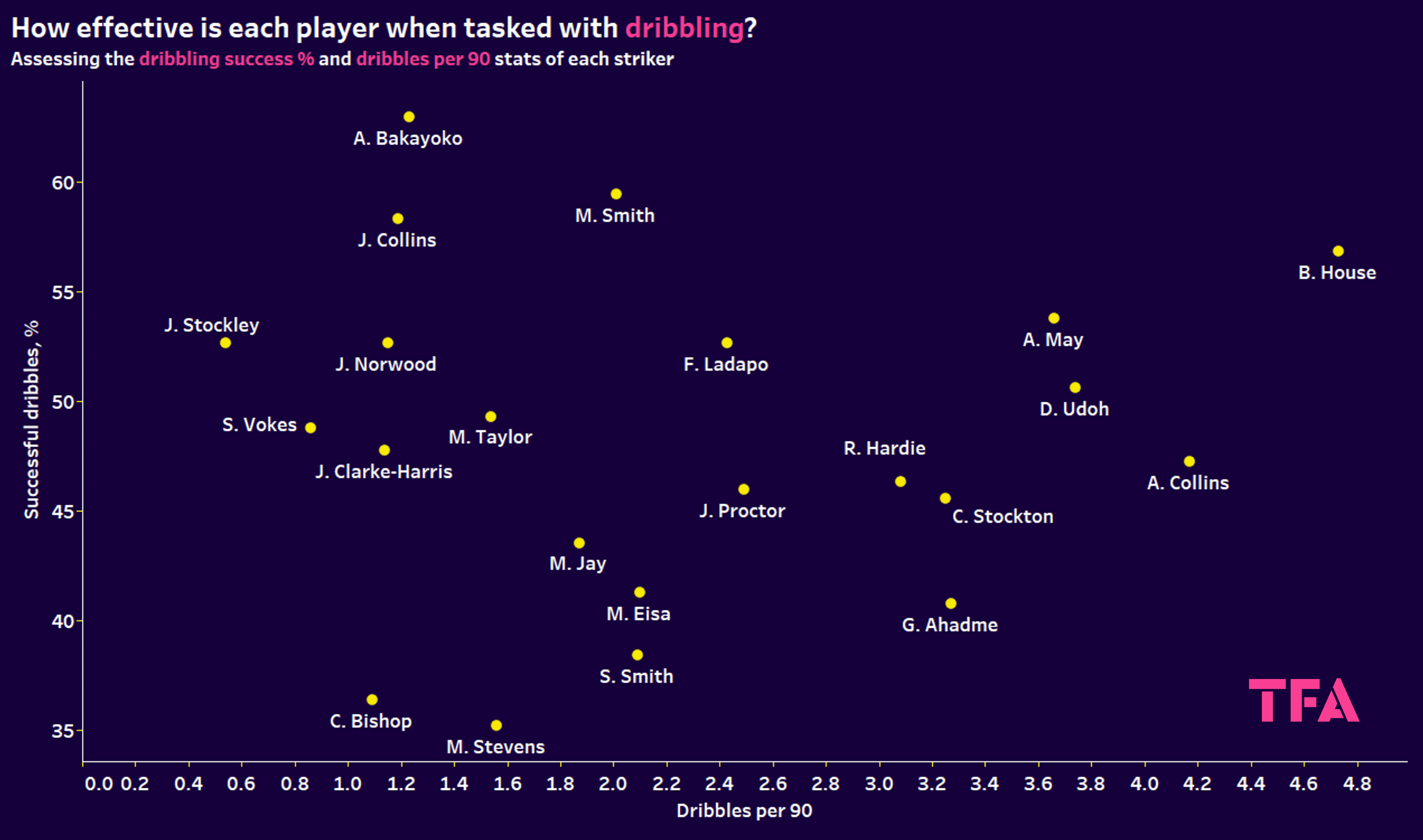
Dribbling is another important skill for a striker. When you think of dribbling, your mind may race to quick and tricky wide players or aggressive central midfielders, but strikers also need to be competent when travelling with the ball. Running at an opposition defender or even running in a one-on-one scenario with the goalkeeper requires good ball control and composure alongside decent pace. The graph above measures the average number of dribbles made by each player per 90, along with a success percentage.
Ben House immediately jumps out as someone with decent dribbling ability – according to the statistics anyway. With the highest average number of dribbles per 90 in this data set (4.73), he shows confidence and determination to carry the ball himself. His success rate of 56.84% is one of the higher rates, showing consistency and danger in his dribbling.
While James Collins (58.33%) and Michael Smith (59.46%) both show a good ability to travel with the ball according to the data, it is yet again Bolton’s Bakayoko who impresses the most. Despite his low average of 1.23 dribblers per 90, he boasts an excellent success rate of 62.96%, the highest in the data set. Registering those numbers suggests that while he is not required to dribble as much – as he did have one of the higher averages for passes per 90 also, he is reliable when moving with the ball and can cause some danger when doing so.
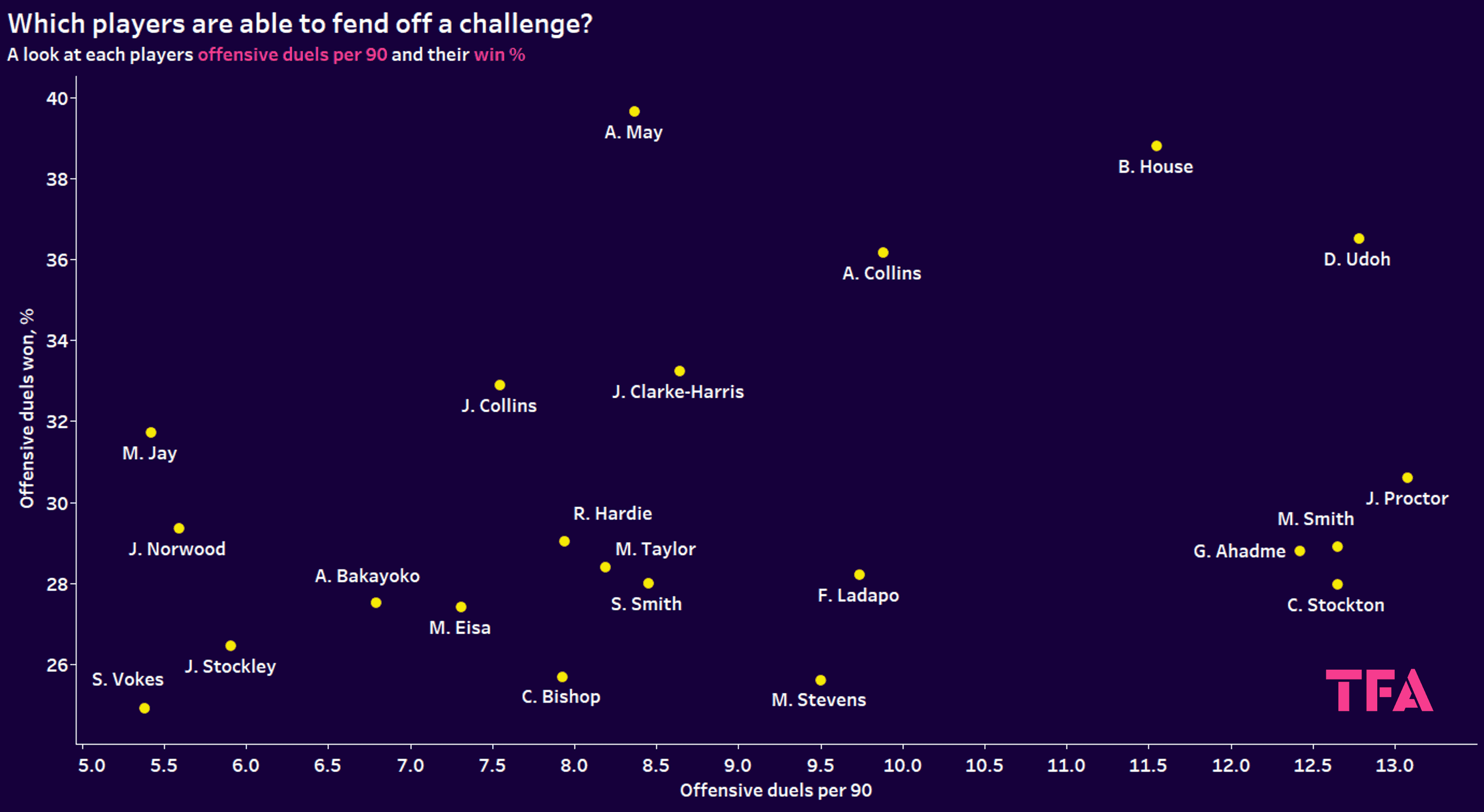
The final two graphs will provide statistical representations of the physicality of each player, first looking at their performance in an offensive duel. Being able to keep the ball under pressure/tackles is a priceless skill to have, especially when deployed in dangerous positions and/or scenarios. Above, we look at the average number of offensive duels per 90 for each striker, along with their win rate.
Alfie May, a striker who rose through the non-league ranks before earning his shot at the Football League, has shown a great desire to develop in a variety of areas over the years. He is now well-established in League One and League Two football, and his aggressiveness and physicality reflect that in a positive way. He boasts the highest win rates from this data set, winning 39.65% of his offensive duels, of which he averages 8.37 per 90. This shows consistency in being able to fend off opposition pressure, allowing him and his side to sustain the attack.
Ben House also impresses with a slightly lower win rate of 38.79%, but he does have a higher average per 90, with 11.5. Both players could be vital for their respective teams because of this trait, especially in those tricky, evenly contested games that occur in League One often.

Finally, we analyse the defensive performance of these strikers to wrap things up. While you may initially think that this is less important than any other area we have analysed in this report, it’s important to remember that strikers can undertake defensive actions in the opposition half – in dangerous areas. The graph above essentially measures how many tackles each striker attempts per 90 next to their success rate in doing so.
There is a trend with this set of statistics – the more defensive duels per 90 = a lower success rate seems to be the theme for the majority of players, but not all. Daniel Udoh had a fairly high average of 4.67 per 90 last season, with an impressive success rate of 61.35%, showing some steel in his game.
Colby Bishop is the man who recorded the highest success rate over the course of the season, winning 64.49% of his 2.12 per 90 – while he doesn’t get too involved defensively (this may be down to club tactics), he is very reliable when called on.
Conclusion
The aim of this data analysis was to highlight potential star strikers of the 2022/23 season based on performances from the 2021/22 campaign, looking at a variety of areas to determine who would be effective in different ways. It’s fair to say that we cannot name a favourite to take home the golden boot for this season, but out of the players included in this data set, you would expect to see a few of these names on the top scorers’ list come to the end of the season.
Bakayoko could be a highly important player for Bolton as he possesses good versatility and can offer a threat in a number of different ways, not just scoring goals. The high scorers we mentioned with the first graph of this analysis will look to be the danger-men leading the line again for their clubs, while players like Sam Vokes and James Collins will utilise their experience to bring points to their respective clubs.

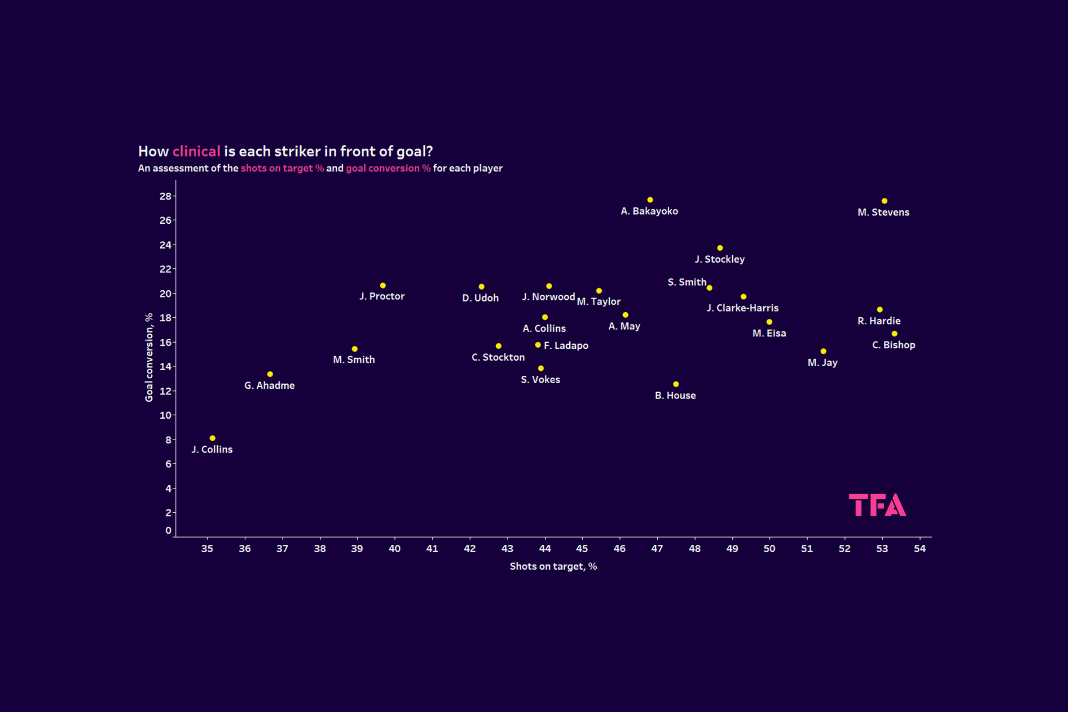




Comments